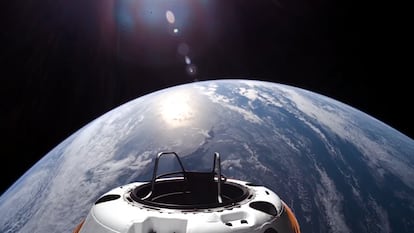‘Polaris Dawn’ reaches 870 miles from Earth, new record for highest orbit achieved by humans
SpaceX-operated spacecraft achieves first goal to measure radiation risk, and astronauts Sarah Gillis and Anna Menon become the women who have flown the furthest in history

SpaceX has confirmed that the Polaris Dawn mission reached an apogee (high point) of 870 miles (1,400 kilometers) from the Earth’s surface during its orbit around our planet. Never before had a manned spacecraft traveled that far other than to the Moon, more than 50 years ago. The four members of the commercial crew inside the Resilience capsule on Tuesday reached a distance that has only been surpassed by the Apollo missions, which ended in December 1972.
In the years leading up to the Moon landing, another NASA spacecraft that orbited around the Earth — Gemini 11 — had set a record that remained unbeaten until now. During its four-day flight from September 12 to 15, 1966, it reached an orbit of 1,373 kilometers (843 miles) at its apogee. And no one had orbited that high since. At most, at less than half that altitude, when a NASA shuttle was launched in April 1990 to deploy the Hubble Space Telescope, which orbits 570 kilometers (350 miles) above Earth.
Achievement unlocked - apogee 1,400.7 km
— SpaceX (@SpaceX) September 11, 2024
Forward bulkhead Draco firing during burn 🔥 pic.twitter.com/Z7kUTcA2CH
The Resilience capsule, a Crew Dragon model spacecraft that SpaceX has adapted for the challenges of the Polaris Dawn mission, reached the new orbital height record almost 15 hours after its launch yesterday from Cape Canaveral (Florida). It first completed eight elliptical orbits, passing overhead at an altitude of 190 kilometers at its closest point to Earth and reaching as far away as 1,200 kilometers. It was then that the ship fired its engines again, to raise the apogee to 1,400 kilometers.
This is the second time that Jared Isaacman, founder of the payment processing company Shift4 and the commander and billionaire sponsor of the Polaris Dawn mission Isaacman, has flown into space. The rest of the crew was made up of a retired U.S. Air Force pilot, Scott Poteet, and mission specialists Sarah Gillis and Anna Menon. Both marked two milestones yesterday, becoming the first members of the SpaceX staff to travel to space. And as of today, Gillis and Menon are also the women who have flown the furthest in history, beating the record of 621 km set by NASA astronaut Kathryn Sullivan, when she participated in the deployment of the Hubble in 1990.
Polaris Dawn and Dragon at 1,400 km above Earth – the farthest humans have traveled since the Apollo program over 50 years ago pic.twitter.com/rRDeD1dY1e
— SpaceX (@SpaceX) September 11, 2024
Another critical moment of the mission will come on Thursday, during the third day of the mission: then, the Dragon capsule hatch will open and the entire crew will experience the complete vacuum of floating in open space, something that very few of the current astronauts get to do. In addition, two of the crew members, Isaacman and Gillis, will then take a spacewalk that will be the first private one; that is, carried out by astronauts who do not belong to a government space agency. With all these ambitious milestones ahead, SpaceX has designed a new spacesuit that it is testing for the first time on this mission.
Sign up for our weekly newsletter to get more English-language news coverage from EL PAÍS USA Edition
Tu suscripción se está usando en otro dispositivo
¿Quieres añadir otro usuario a tu suscripción?
Si continúas leyendo en este dispositivo, no se podrá leer en el otro.
FlechaTu suscripción se está usando en otro dispositivo y solo puedes acceder a EL PAÍS desde un dispositivo a la vez.
Si quieres compartir tu cuenta, cambia tu suscripción a la modalidad Premium, así podrás añadir otro usuario. Cada uno accederá con su propia cuenta de email, lo que os permitirá personalizar vuestra experiencia en EL PAÍS.
¿Tienes una suscripción de empresa? Accede aquí para contratar más cuentas.
En el caso de no saber quién está usando tu cuenta, te recomendamos cambiar tu contraseña aquí.
Si decides continuar compartiendo tu cuenta, este mensaje se mostrará en tu dispositivo y en el de la otra persona que está usando tu cuenta de forma indefinida, afectando a tu experiencia de lectura. Puedes consultar aquí los términos y condiciones de la suscripción digital.
More information
Archived In
Últimas noticias
The journal ‘Science’ criticizes Trump’s anti-renewable energy policy: ‘The US is failing to benefit from its own innovations’
Cubans hope for a miracle as dengue and chikungunya spread
The long shadow of the father figure in the films of Rob Reiner
US sanctions against jailed cartel leader ‘El Marro’ highlight Mexico’s lack of control over its prisons
Most viewed
- Christian Louboutin: ‘Young people don’t want to be like their parents. And if their parents wear sneakers, they’re going to look for something else’
- ‘El Limones’ and the growing union disguise of Mexican organized crime
- Cartels in Mexico take a leap forward with narco-drones: ‘It is criminal groups that are leading the innovation race’
- ‘We are dying’: Cuba sinks into a health crisis amid medicine shortages and misdiagnosis
- The low-cost creative revolution: How technology is making art accessible to everyone











































